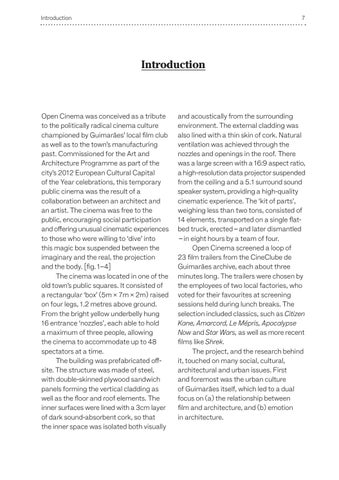Introduction 7
Introduction
Open Cinema was conceived as a tribute to the politically radical cinema culture championed by Guimarães’ local film club as well as to the town’s manufacturing past. Commissioned for the Art and Architecture Programme as part of the city’s 2012 European Cultural Capital of the Year celebrations, this temporary public cinema was the result of a collaboration between an architect and an artist. The cinema was free to the public, encouraging social participation and offering unusual cinematic experiences to those who were willing to ‘dive’ into this magic box suspended between the imaginary and the real, the projection and the body. [fig. 1–4] The cinema was located in one of the old town’s public squares. It consisted of a rectangular ‘box’ (5m × 7m × 2m) raised on four legs, 1.2 metres above ground. From the bright yellow underbelly hung 16 entrance ‘nozzles’, each able to hold a maximum of three people, allowing the cinema to accommodate up to 48 spectators at a time. The building was prefabricated offsite. The structure was made of steel, with double-skinned plywood sandwich panels forming the vertical cladding as well as the floor and roof elements. The inner surfaces were lined with a 3cm layer of dark sound-absorbent cork, so that the inner space was isolated both visually
and acoustically from the surrounding environment. The external cladding was also lined with a thin skin of cork. Natural ventilation was achieved through the nozzles and openings in the roof. There was a large screen with a 16:9 aspect ratio, a high-resolution data projector suspended from the ceiling and a 5.1 surround sound speaker system, providing a high-quality cinematic experience. The ‘kit of parts’, weighing less than two tons, consisted of 14 elements, transported on a single flatbed truck, erected – and later dismantled – in eight hours by a team of four. Open Cinema screened a loop of 23 film trailers from the CineClube de Guimarães archive, each about three minutes long. The trailers were chosen by the employees of two local factories, who voted for their favourites at screening sessions held during lunch breaks. The selection included classics, such as Citizen Kane, Amarcord, Le Mépris, Apocalypse Now and Star Wars, as well as more recent films like Shrek. The project, and the research behind it, touched on many social, cultural, architectural and urban issues. First and foremost was the urban culture of Guimarães itself, which led to a dual focus on (a) the relationship between film and architecture, and (b) emotion in architecture.
